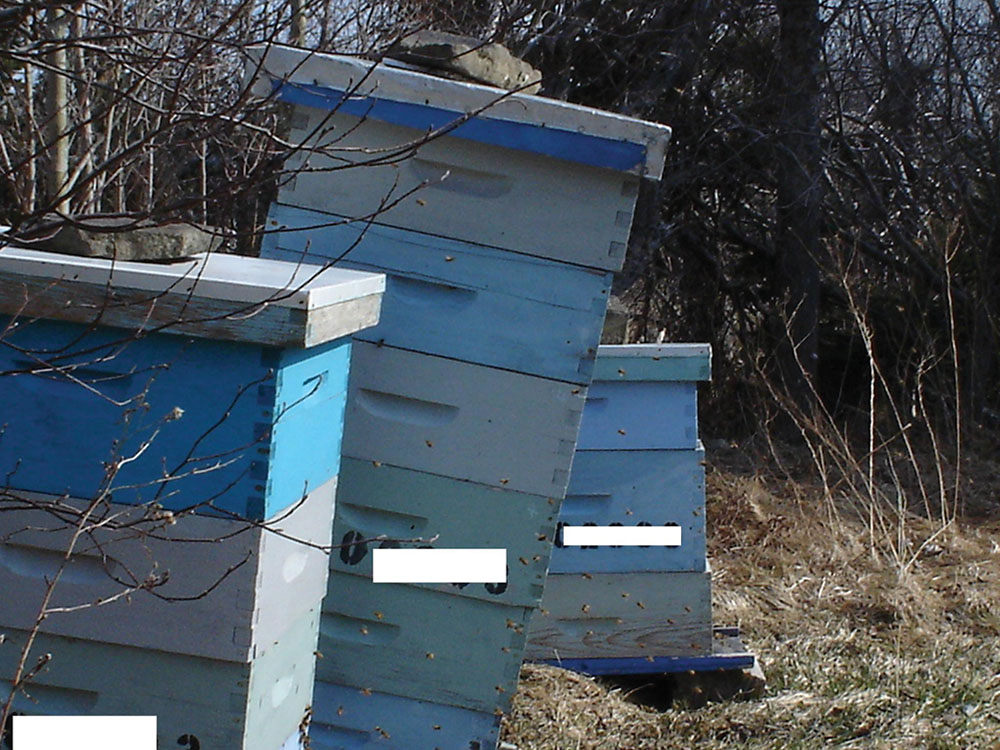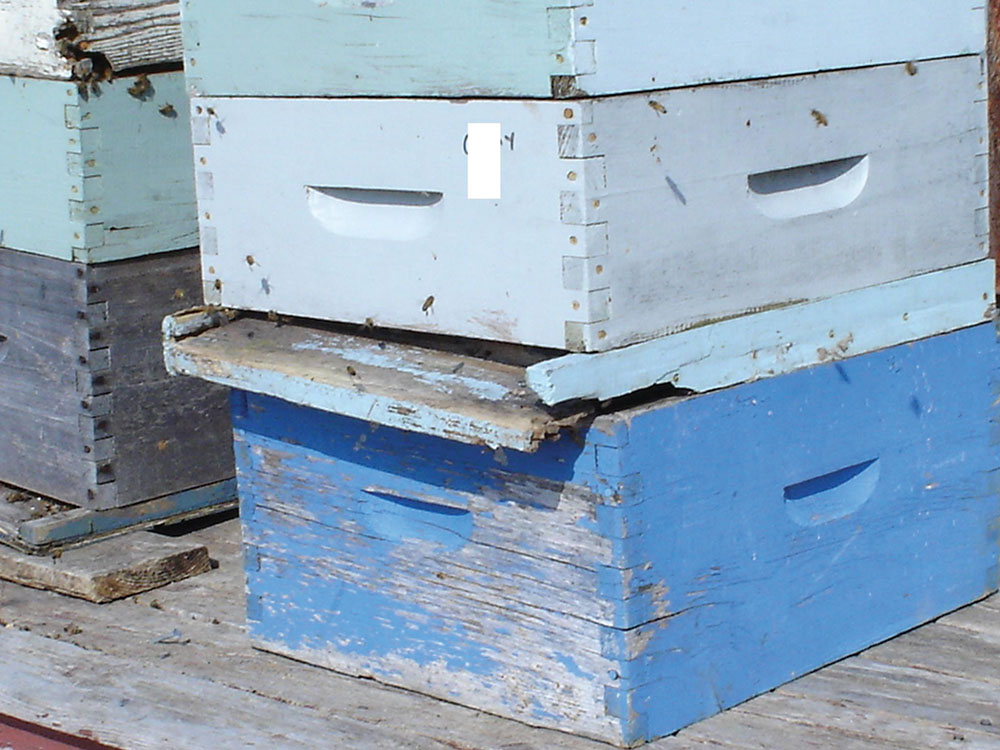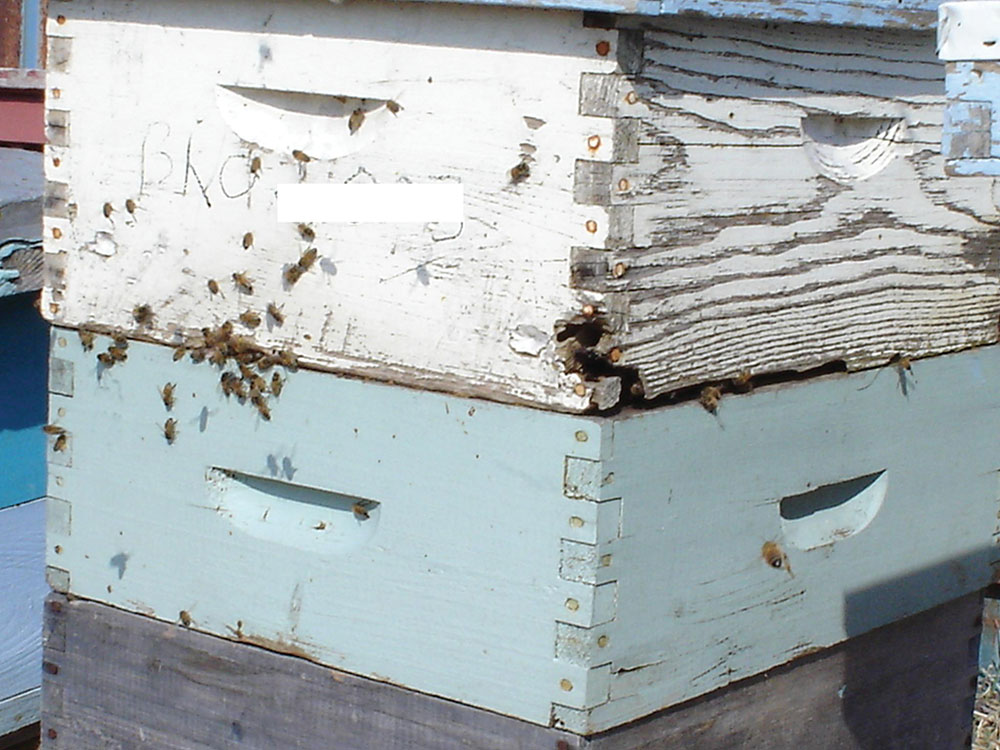by Michael Magnini
1
The message was clearly seared into the flesh of my face and chest. With my left eye swollen shut, I stared into the bathroom mirror through one watery eye. My hands were shaking as I plucked hot bee stingers from my cheek, forehead, eyebrow, and across my bare chest. My only thought was, I really didn’t see that coming.
Later my neighbor recounted the incident with an odd sort of chuckle. “All I heard was (the) thumping pounding of feet pass my kitchen window. I looked up and out, and there he was – running like the devil himself was chasing him. Then, by-the-jezz, I heard the bees. Hundreds and hundreds of ‘em. And angry they were chasing the poor lad. He zigged and zagged, runnin’ through the woods and tripped over a stump. Then he rolled, waving his arms about and hurled himself down into the river. It was the craziest thing I did see here in a long time.”
So, this I learned the “hard way,” is what happens when you push your gas-powered lawnmower past the front step of a big, busy beehive on a hot and sunny afternoon. The path to good beekeeping is often paved with stingers.
On the good days it is so easy to forget that bees have stingers. The young woman was eager to see the honey bees in her new boyfriend’s yard. He wanted to impress her with the ‘magic’ of beekeeping. Together they walked into the yard on a typical sunny Summer day. Why wouldn’t the bees be happy and friendly? The clover and wildflowers were in bloom and the nectar flow was good. As they approached the four hives in a neat row they could hear the pleasant hum of their foraging. Streams of bees were flowing to and from the hive entrances. Calmly, hand in hand, and without veils over their faces they walked through the meadow flowers. She smiled at the lovely pastoral scene. It was then that a few guard bees took exception to the young lady’s long black hair. Whizzing like bullets they drove their stingers into her scalp and forehead. She screamed and attempted to fly away like a frightened bird by waving her arms rapidly at her sides. Her former boyfriend didn’t even have his smoker lit. The good beekeeper is mindful of the sharpness of the little bees’ stinger, and eyes.
2
Sometimes at college one can be heard to say, “Oh, I missed that class.” Or the overeager newbee might have skipped that chapter in the textbook. Such was the case when visiting a beginning beekeeper at his new apiary overlooking the beautiful Bras’ d Or Lake. His 10 hives were very busy and full, foraging steadily on that mid-Summer’s day. He was attempting to make adjustments to his brood chambers as I arrived for a visit. My experience at beekeeping often leads to many inquires for advice on this topic or that. I parked my car and walked over to a small group of busy beekeepers. The hives were in various stages of disassembly, frames here and there and hundreds of bees flying every which way. The newbee had placed several medium depth honey supers on a nearby picnic table. A vast cloud of bees was circling the stacked supers emitting a loud buzz as their feeding frenzy expanded.
“I can’t get the bees to go back to their hives,” he said with a heavy sigh.
“You can’t leave your honey supers out like that,’ I told him, “even on a good day. The robber bees will steal all your honey.”
“Bees steal honey?” he said as sunlight gleamed from his sweat-laden forehead. Understanding the basic nature of the Apis mellifera provides a calm and efficient manner to the good beekeeper’s efforts.
3
The practical beekeeper keeps the hive bodies of his colonies in fine repair and prime condition. However, some beekeepers do not see the need or have an inclination towards upright hives that are stable and well protected. One winter’s day, I visited a beekeeper neighbour who had a rather manic/depressive relationship with his bees. On this particular day in February he was quite excited about the bees and the coming season. In his exuberance he led me outside to “examine the bees.” We trudged through the snow in -5°C (25°F) clear air and sunshine until we reached his closest hives. As he delivered a continuous monologue of beekeeping theories and organic methods he removed an outer lid, then popped the inner lid with his hive tool. Looking down onto the clearly disturbed Winter cluster he continued to expound his ideas of ‘better beekeeping’.
I said that the colony would not be able to reseal the lid due to the lack of propolis and the cold conditions, and he replied, “They’ll be okay. There’re tough.”
Later that Spring he was much less optimistic about his bees’ health. The simple moral here is that bees work in the Summer, and rest in the Winter – let them be.
4
Sometimes the beekeeping fever compels people to jump into the ‘deep end’. I recall an enthusiastic newcomer to the beekeeping trade. I asked him, one day, what type of beekeeping he intended to develop. “I’m going to do everything!” he announced confidently. I inquired as to his plans. “I’m going to build up to 50 hives the first year. Then, I’ll rent out the hives to the farms for apples and blueberries. Then, I’ll move them to the ‘honey fields’ and sell specialty honey in gift boxes.”
Really? “Oh, yes. And next year I’m going to produce queens for sale too.”
Are you keeping your regular job? “Yah, I have to – I just bought a new 4×4 with extra heavy duty package to haul my beehives around.”
I wished him luck and went back to work in my apiary. By the end of the year I had heard that he had actually moved one hive (in his extra heavy duty truck) to an apple orchard some 30 miles from his house. I heard this when the owner of the apple orchard called me to ask what he should do about the large swarm in his apple tree.
The good beekeeper learns his craft and grows his business.
5
Then, sometimes, a beekeeper likes to show off to the uninitiated or uninformed. Such was the case when I met a young person at the local farm market. She and her friend brought my attention to a lovely bumblebee resting on a railing. They of course were excited and nervous. To demonstrate the bee’s gentleness I coaxed it into my hand and showed the amazed girls its charms. Once the demonstration was over the youngsters scampered away and I was needed at my table. So, to dismiss the bumblebee I casually blew a gentle stream of warm air from my mouth against its backside. The bumblebee casually stung me in the finger and flew away. The simple lesson here is never blow up a bee’s butt.
6
And sometimes, what comes from a person’s mouth is not the same as what his hands are doing. One fellow beekeeper insisted on the importance of using ‘organic’ and natural methods of beekeeping. His rules included: must not feed sugar to bees, only honey, and no artificial hive parts, only wax foundation (that you should make yourself), and no treatment for mites and pests.
Thus, was I most stunned to see him stuff baler twine (the kind that is soaked in rodenticide) into his smoker, light it and generously smoke his hives as he gave me a tour of his natural bee colonies.
7
Stacks and stacks of bee boxes leaning to the left and to the right seldom makes a good apiary. So, it was on a Summer’s day that I paid a visit to a neighbouring beekeeper. It was my intent on that day to add to my database of the Honey Plants of Eastern Canada. I met the beekeeper at the back door of his country house, and spoke to him through the screen. “Would you mind if I took photographs of your bees?” I asked him. “Oh, no. Go ahead. I’ll be out in a little while to work on them,” he replied.
I searched some of the conspicuous flowers for foraging bees and found many, mostly honey bees. A few interesting photos were taken of bees on mint and basil flowers blooming in his wife’s garden. I then made my way down the sloping pasture to his apiary tucked into the bottom corner of the field. It was a stunning view. Hundreds of bees were flying from multiple holes in the sides, fronts and backs of the dozen or so Langstroth hives in his yard. Many had broken bottom boards and were leaning precariously forward, and to either side. I thought, Has there been an earthquake?
Living in Nova Scotia, Canada clearly ruled out that possibility, although it is very stormy here. However, I could not believe that this was caused by one or two rainy days. These hives simply have not been moved since they were first set in place.
I had just finished photographing these bad beehives when the owner and beekeeper came lumbering down the hill with his smoker in hand. He had stuffed his overweight frame into a dirty, white bee suit. On his approach he yelled, “Great day for nectar!” When he reached me, he placed his smoker on the ground and sank to one knee. As he drew a match to light the can, he said, though out of breath and puffing, “Yah. I have a problem with the bees in the last hive. It might be queenless.”
We pulled the hive apart and examined the brood chambers to confirm that the hive had indeed swarmed.
“Oh, well,” he said, as we finished replacing the cracked and pealing cover, “that’s enough for today. Let’s go have a beer.”
The good, dedicated beekeeper maintains a neat, clean and secure apiary.
8
Shall we talk about the person who wants (to save the bees perhaps) to own a beehive or two? I made the casual inquiry, “how are your bees?” to the new member of our beekeepers club. “Oh, they’re fine,” he said in a slow, deliberate way. “I watch them on Sunday afternoons, while I cool off with a cold beer under my shade tree.” He smiled a big toothy grin. I asked about the size of the brood in his hive. “Okay, I guess. Don’t know, really. I haven’t looked,” he replied casually. When was the last time you opened your hive, I inquired with some curiosity. “Last year, I think. There’re pretty good at taking care of their selves. I like them bees. Not much work to ‘em.” He went on about how interesting and relaxing it is to watch the bees flying in and out of the hive with big packs of pollen and such . . .
Later that day, I installed a swarm trap in a tree across the road from the owner’s backyard and a fine, ‘free-range’ beehive.
9
Swarms are awe inspiring, intriguing and enticing. They garner much media attention when in populated areas and often get people quite excited. To a beekeeper they see something else. Although exciting, it is the excitement of the hunt. To a beekeeper a swarm represents new blood, a rich resource, money in the bank – free bees.
However, catching swarms is not always a simple or easy matter. One day in August I returned home from the Saturday Farm Market to discover a newly emerged swarm high up (40 feet) in a large spruce tree. I thought of it as a routine recovery. So, I gathered an empty deep super with frames, a set of heavy hand loppers, and a tall aluminium extension ladder. Although it was a very hot day, I wore a full bee suit with gloves for the capture.
With the ladder in place and secure, I climbed it to the very top. This is where it began to get tricky. The swarm (a very large and heavy one) hung about two feet above my head. Undaunted, I reached up with the loppers and hooked the two inch thick branch. Then, trying to squeeze the handles together with one hand and my inner elbow I reached precariously out with my other hand to ‘catch’ the severed branch and the swarm.
As I cut halfway through the branch the weight of the great swarm caused it to break and hinge downwards quickly enough for the swarm to hit me in the face. The bees exploded into flight and proceeded to sting me numerous times.
I retreated quickly down the ladder, and abandoned the swarm capture. Most of these bees resettled later in the afternoon, and by the next day the swarm had flown off to some new nest site beyond my survey.
I applied balm to my stings and scratches, and contemplated the fiasco that had just occurred. To make the experience more humbling and regrettable was the video shot and recorded by my neighbour, who I had invited over for a ‘lesson in beekeeping.’
Of course, how else would we learn that swarms must be captured in a safe and controlled manner? To do otherwise is to court disaster of some kind or another.
All these stories are true. I have either experienced them myself (with chagrin) or witnessed them. With the exception of the author, all names have been withheld.
It takes time to become proficient, knowledgeable and skilled at beekeeping. Along the way one is bound to make mistakes and learn from them. This is not bad beekeeping – unless you repeat these mistakes often enough to cause you or your bees serious problems.











